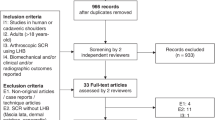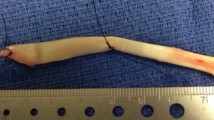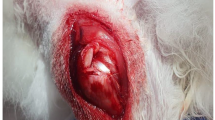Abstract
Background
Pathology in the long head of the biceps tendon often occurs in patients with rotator cuff tears. Arthroscopic tenotomy is the most common treatment. However, the role of the long head of the biceps at the shoulder and the consequences of surgical detachment on the remaining shoulder structures remain unknown.
Questions/purposes
We hypothesized that detachment of the long head of the biceps, in the presence of supraspinatus and infraspinatus tears, would decrease shoulder function and decrease mechanical and histologic properties of both the subscapularis tendon and the glenoid articular cartilage.
Methods
We detached the supraspinatus and infraspinatus or the supraspinatus, infraspinatus, and long head of the biceps after 4 weeks of overuse in a rat model. Animals were gradually returned to overuse activity after detachment. At 8 weeks, the subscapularis and glenoid cartilage biomechanical and histologic properties were evaluated and compared.
Results
The group with the supraspinatus, infraspinatus, and long head of the biceps detached had greater medial force and decreased change in propulsion, braking, and vertical force. This group also had an increased upper and lower subscapularis modulus but without any differences in glenoid cartilage modulus. Finally, this group had a significantly lower cell density in both the upper and lower subscapularis tendons, although cartilage histology was not different.
Conclusions
Detachment of the long head of the biceps tendon in the presence of a posterior-superior cuff tear resulted in improved shoulder function and less joint damage in this animal model.
Clinical Relevance
This study provides evidence in an animal model that supports the use of tenotomy for the management of long head of the biceps pathology in the presence of a two-tendon cuff tear. However, long-term clinical trials are required.






Similar content being viewed by others
References
Burkhart SS. Arthroscopic treatment of massive rotator cuff tears: clinical results and biomechanical rationale. Clin Orthop Relat Res. 1991;267:45–56.
Chen CH, Hsu KY, Chen WJ, Shih CH. Incidence and severity of biceps long head tendon lesion in patients with complete rotator cuff tears. J Trauma. 2005;58:1189–1193.
D’Addesi LL, Anbari A, Reish MW, Brahmabhatt S, Kelly JD. The subscapularis footprint: an anatomic study of the subscapularis tendon insertion. Arthroscopy. 2006;22:937–940.
Elser F, Braun S, Dewing CB, Giphart JE, Millett PJ. Anatomy, function, injuries, and treatment of the long head of the biceps brachii tendon. Arthroscopy. 2011;27:581–592.
Hayes WC, Keer LM, Herrmann G, Mockros LF. A mathematical analysis for indentation tests of articular cartilage. J Biomech. 1972;5:541–551.
Ide J, Tokiyoshi A, Hirose J, Mizuta H. An anatomic study of the subscapularis insertion to the humerus: the subscapularis footprint. Arthroscopy. 2008;24:749–753.
Kido T, Itoi E, Konno N, Sano A, Urayama M, Sato K. Electromyographic activities of the biceps during arm elevation in shoulders with rotator cuff tears. Acta Orthop Scand. 1998;69:575–579.
Kido T, Itoi E, Konno N, Sano A, Urayama M, Sato K. The depressor function of biceps on the head of the humerus in shoulders with tears of the rotator cuff. J Bone Joint Surg Br. 2000;82:416–419.
Kim SJ, Lee IS, Kim SH, Woo CM, Chun YM. Arthroscopic repair of concomitant type II SLAP lesions in large to massive rotator cuff tears: comparison with biceps tenotomy. Am J Sports Med. 2012;40:2786–2793.
Lakemeier S, Reichelt JJ, Timmesfeld N, Fuchs-Winkelmann S, Paletta JR, Schofer MD. The relevance of long head biceps degeneration in the presence of rotator cuff tears. BMC Musculoskelet Disord. 2010;11:191.
Levy AS, Kelly BT, Lintner SA, Osbahr DC, Speer KP. Function of the long head of the biceps at the shoulder: electromyographic analysis. J Shoulder Elbow Surg. 2001;10:250–255.
Lo IK, Burkhart SS. The etiology and assessment of subscapularis tendon tears: a case for subcoracoid impingement, the roller-wringer effect, and TUFF lesions of the subscapularis. Arthroscopy. 2003;19:1142–1150.
Mazzocca AD, McCarthy MB, Ledgard FA, Chowaniec DM, McKinnon WJ Jr, Delaronde S, Rubino LJ, Apolostakos J, Romeo AA, Arciero RA, Beitzel K. Histomorphologic changes of the long head of the biceps tendon in common shoulder pathologies. Arthroscopy. 2013;29:972–981.
Peltz CD, Perry SM, Getz CL, Soslowsky LJ. Mechanical properties of the long-head of the biceps tendon are altered in the presence of rotator cuff tears in a rat model. J Orthop Res. 2009;27:416–420.
Perry SM, Getz CL, Soslowsky LJ. After rotator cuff tears, the remaining (intact) tendons are mechanically altered. J Shoulder Elbow Surg. 2009;18:52–57.
Reuther KE, Sarver JJ, Schultz SM, Lee CS, Sehgal CM, Glaser DL, Soslowsky LJ. Glenoid cartilage mechanical properties decrease after rotator cuff tears in a rat model. J Orthop Res. 2012;30:1435–1439.
Reuther KE, Thomas SJ, Evans EF, Tucker JJ, Sarver JJ, Ilkhani-Pour S, Gray CF, Voleti PB, Glaser DL, Soslowsky LJ. Returning to overuse activity following a supraspinatus and infraspinatus tear leads to joint damage in a rat model. J Biomech. 2013;46:1818–1824.
Reuther KE, Thomas SJ, Sarver JJ, Tucker JJ, Lee CS, Gray CF, Glaser DL, Soslowsky LJ. Effect of return to overuse activity following an isolated supraspinatus tendon tear on adjacent intact tendons and glenoid cartilage in a rat model. J Orthop Res. 2013;31:710–715.
Rubin D. Multiple Imputation for Nonresponse in Surveys. New York, NY: John Wiley & Sons; 1987.
Sarver JJ, Dishowitz MI, Kim SY, Soslowsky LJ. Transient decreases in forelimb gait and ground reaction forces following rotator cuff injury and repair in a rat model. J Biomech. 2010;43:778–782.
Soslowsky LJ, Carpenter JE, DeBano CM, Banerji I, Moalli MR. Development and use of an animal model for investigations on rotator cuff disease. J Shoulder Elbow Surg. 1996;5:383–392.
Soslowsky LJ, Thomopoulos S, Tun S, Flanagan CL, Keefer CC, Mastaw J, Carpenter JE. Neer Award 1999. Overuse activity injures the supraspinatus tendon in an animal model: a histologic and biomechanical study. J Shoulder Elbow Surg. 2000;9:79–84.
Su WR, Budoff JE, Luo ZP. The effect of posterosuperior rotator cuff tears and biceps loading on glenohumeral translation. Arthroscopy. 2010;26:578–586.
Szabo I, Boileau P, Walch G. The proximal biceps as a pain generator and results of tenotomy. Sports Med Arthrosc. 2008;16:180–186.
Thomas SJ, Miller KS, Soslowsky LJ. The upper band of the subscapularis tendon in the rat has altered mechanical and histologic properties. J Shoulder Elbow Surg. 2012;21:23–31.
Thomopoulos S, Williams GR, Soslowsky LJ. Tendon to bone healing: differences in biomechanical, structural, and compositional properties due to a range of activity levels. J Biomech Eng. 2003;125:106–113.
Yamaguchi K, Riew KD, Galatz LM, Syme JA, Neviaser RJ. Biceps activity during shoulder motion: an electromyographic analysis. Clin Orthop Relat Res. 1997;336:122–129.
Yamamoto A, Takagishi K, Osawa T, Yanagawa T, Nakajima D, Shitara H, Kobayashi T. Prevalence and risk factors of a rotator cuff tear in the general population. J Shoulder Elbow Surg. 2010;19:116–120.
Zhang Q, Zhou J, Ge H, Cheng B. Tenotomy or tenodesis for long head biceps lesions in shoulders with reparable rotator cuff tears: a prospective randomised trial. Knee Surg Sports Traumatol Arthrosc. 2013 July 5 [Epub ahead of print].
Acknowledgments
The authors thank Andrew Dunkman BS, Liz Feeney, Benjamin Freedman BS, and Corinne Riggin BS for their contribution to the overuse protocol. We also thank Rameen Vafa, George Fryhofer BS, and Alex Delong BS for their contribution to histology.
Author information
Authors and Affiliations
Corresponding author
Additional information
The institution of the authors received, during the study period, funding from NIH/NIAMS (Bethesda, MD, USA) (Grant R01AR056658) and the Penn Center for Musculoskeletal Disorders (Philadelphia, PA, USA) (NIH Grant P30 AR050950). Each author certifies that he or she, or a member of his or her immediate family, has no commercial associations (eg, consultancies, stock ownership, equity interest, patent/licensing arrangements, etc) that might pose a conflict of interest in connection with the submitted article.
All ICMJE Conflict of Interest Forms for authors and Clinical Orthopaedics and Related Research editors and board members are on file with the publication and can be viewed on request.
Each author certifies that his or her institution approved the animal protocol for this investigation and that all investigations were conducted in conformity with ethical principles of research.
About this article
Cite this article
Thomas, S.J., Reuther, K.E., Tucker, J.J. et al. Biceps Detachment Decreases Joint Damage in a Rotator Cuff Tear Rat Model. Clin Orthop Relat Res 472, 2404–2412 (2014). https://doi.org/10.1007/s11999-013-3422-8
Published:
Issue Date:
DOI: https://doi.org/10.1007/s11999-013-3422-8




